The kits are alright
With a new season on the horizon, and therefore a new kit, Col takes From Bromley with Love on a magical history tour through our kits of the last half-century.
Since I first walked through the turnstiles at Hayes Lane in 1977, the club’s home kit has largely been white shirts, black shorts and black socks. Although, prior to this, they had worn white with blue trim on occasion. Sacrilege?
For my first couple of seasons, Bromley’s kit was made by Admiral, the one-time giants of English sportswear. It was a direct copy of Manchester United’s kit, with white for the home shirts and red for the away.
The club shop didn’t sell replica shirts in the ‘70s. But, if you were crafty, you could buy a sew-on Bromley club crest and stitch it onto a Man Utd shirt from your local sports shop. The lengths we went to!
For the remainder of the ‘70s, Bromley wore a pretty plain kit. However, they did briefly change the club crest to a single raven.
The 1980s were famous for super-short shorts, but that wasn’t the only kit change to occur at Hayes Lane. For one season, we had red trim, along with red numbers and socks, not dissimilar to Liverpool’s away kit at the time. While we reverted to the traditional black and white soon after, more changes lay ahead.
Our first-ever shirt sponsor arrived in 1982 when local sports shop Cocosport decided to back the Ravens for the 1982/83 season. More shirt sponsors followed as the decade wore on, and Bromley’s kit also endured the addition of pinstripes and, later on, shadow stripes.
The 1982 team in the kits with red trim (take my word for it). A shirt sponsor would soon follow.
The away kit remained red in the ‘80s, but there was an Inter Milan-style blue and black number that had an occasional outing. And, for one game against Faversham, we wore blue shirts with yellow shorts, but I never found out why. Can anyone enlighten me?
Billy Bingham was born in July 1990. Feel old now?
For Bromley, the go-go ‘90s began with a return to a full-colour badge and a change to white socks. Manufactured by New Olympic, this was the smartest kit we’d had in a long time. That season ended in promotion, too, so it will always bring back good memories for me.
Another supplier during this decade was Pro Star. They may be better known for their Sunday League togs, but they made a really nice kit for the Ravens, with a full-colour badge and star designs on the sleeves, although this was only ever worn by the reserve team.
However, when Diadora began sponsoring the Isthmian League, every team involved had to wear a kit made by them. Imagine a sports brand trying to get away with that these days!
Our Diadora kit was a very basic plain white shirt with no badge or sponsor. Was the swing towards minimalism a protest? Who knows. But I think we were all glad to have ICiS take on the kit-supplying duties a year later. Whatever happened to ICiS?
For one season in the ‘90s, our away kit changed to red and green stripes, but this colour combination was short-lived.
During one of the club’s rare outings in this clashy colourway, Mark Loveday dislocated his shoulder and had to be cut out of his shirt. This left the club one shirt short of a match set. When they contacted the manufacturer to arrange a replacement, they didn’t have any more in stock. Imagine not keeping a supply of red and green striped shirts!
Sadly, I can’t find any photos of Bromley wearing this fabled kit. Do any pictures survive?
With money tight at the club, our kits took a turn for the basic in the latter half of the decade. Black pinstripes and iron-on badges were the order of the day, and very little changed until our ill-fated 1998/99 campaign.
Bromley’s kit for that season was made by Hummell, with College Road Radio as the sponsor. Unusually, it had quite a bit of red on it. This wasn’t a good omen.
When Mitchel Bergkamp was born in September 1998, Bromley were top of the table. But by the time he was nine months old, the Ravens had been relegated. The College Road Radio kit was never seen again.
The 2000s started with Bromley struggling on and off the pitch, but they did have a really nice Adidas home kit for a while. That said, to save a few quid, the club wore the same red away kit for so many seasons that it literally fell to pieces in the end.
Carl Bartley in the 2000 Adidas kit. The crest was red.
Bromley were so hard up that for one season in the early noughties we had a plain white shirt with no markings on it except for a basic black badge. It was made by Sunday League stalwarts Pro Star and was probably picked out of the same catalogue used by pub teams up and down the country.
Our 03/04 kit, however, was a radical change. Someone at the club flipped through the Pro Star catalogue and picked out black and white stripes. It wasn’t a popular move. By April, you could buy one in the club shop for a fiver. Which I did. And I still have it 20 years on.
Joe Vines in the controversial striped kit of 2003/04.
When Kellen Fisher was born in 2004 (if you weren’t feeling old before, how about now?), Bromley had a new supplier in the shape of South London firm Kitz. Kitz feathered the Ravens from 2004 to 2006 before Pendle Sportswear came on board at the start of 06/07. That relationship didn’t last, though. By the time Bromley were triumphing in the play-off final at the end of that season, Pendle had been replaced by Valsport.
Legendary striker Wade Falana in the Kitz shirt of 2004.
Winning promotion to the NLS in a Valsport number, May 2007.
Ahead of Bromley’s first season in the National League South in 2009, the club put their kit design to an internet vote. The obscure sportswear brand Accused offered up four home shirt designs and the fans had their say.
It should be noted that the internet was a more naive place back then. The club’s voting system allowed anyone with an internet browser to have multiple votes, leading to one design winning by a suspiciously large number.
Danny Hockton and Donal O'Sullivan in the shirt that won the fans’ vote in 2009.
The winning design might not have been to everyone’s taste, but with its single black sleeve and central crest, it was certainly unique. And it will be fondly remembered as the shirt we wore when Ryan Hall scored that goal against AFC Wimbledon.
From 2010, suppliers like Surridge, Joma, Valsport, and Stand all came and went. The Stand kit had black sleeves and hooped socks. Bizarrely, it also had the sponsor’s tagline, Imagine the Possibilities, printed on the rear of the shorts. The Joma kit was definitely my favourite of this era.
Tutu Henriques in the Surridge Sports kit.
At the start of the 2014/15 season, the club’s new owners, the Reading family, decided to change to an all-white kit. Manufactured by sportswear giants Nike, the shirt itself was nice enough, but traditionalists were not happy with the change from black shorts. That said, photographs show that the team had worn all-white back in the 1960s.
The 67/68 team look all-white.
Bromley won promotion to the National League in 2015, so the all-white Nike kit will forever be associated with that achievement. Sadly, the Readings ran out of money mid-season, so their choice of kit ended up outlasting their ownership of the club.
In the eight years Bromley have been in the National League, we’ve had three different kit manufacturers. We’ve also seen the introduction of gold to the club colours.
The club’s owner, Robin Stanton-Gleaves, oversaw another all-white kit for the 2019/20 season, this time made by Macron. The choice of gold numbers was a little bizarre though, as no one could make them out on the back of the shirt, particularly during night games. I’m sure I made some mistakes in my match reports as a result.
Macron also made our kit for the following season, but with Covid restrictions in place, fans were only able to attend three games during that campaign, so it was mainly seen via a laptop screen.
With fans back in the stadiums for 2021/22, Bromley switched to an all-white Puma kit. But another unhappy relationship was brewing. Problems with supply meant that Puma’s shirt never went on general sale, costing the club thousands in lost revenue.
Ironically, Bromley achieved great success in that Puma kit, booking a date with Wrexham in the final of the FA Trophy. However, by the time we walked up Wembley Way, Puma had been ditched in favour of the Italian slim-fit aficionados, Kappa.
Drawn as the home team, Wrexham insisted on playing in a one-off all-white kit for the game. Not to be outdone, Kappa kitted Bromley out in an all-black number with silver trim.
Even though it was only worn once, the result of the final meant that the black kit instantly became iconic. It certainly sold well in the club shop before and after the game, and its success may have even filled the financial hole created by the Puma catastrophe.
It’s impossible to miss that Kappa supplied our kit for the 2022/23 season as their logo ran the length of the sleeves and shorts. Kappa’s all-red away kit, with white pinstripes, probably won’t live long in the memory. The teal third kit, however, is another matter.
In a distant echo to the internet vote of 2009, the club asked fans to submit designs for a third kit. Several designs were shortlisted by the club and we were asked to vote on a winner.
“There’s a star man playing on the right.”
Marc Edees’ David Bowie-inspired design was the eventual winner, and it has been a popular addition to the club shop. The Bowie theme has broadened the club’s commercial appeal, inspiring orders from far outside the BR postcodes.
The question is, what Bromley will wear in 2023/24?
At the time of writing, the new design has yet to go public, but we can only hope it befits a team with 131 years of non-league history. Who knows, perhaps we’ll make a little more history in it.
What would you like to see in Bromley’s getup for the new season?
Thanks for taking the time to read the article - you can expect more like this as well as videos, audio posts, interviews etc etc
You can find Colin Head on Twitter - here
All articles are edited by Peter Etherington you can link to him here
If you havent as yet make sure you read the other articles in the archive.
If you’d like to show an appreciation for the work that goes into this newsletter you can buy the team a coffee through the link below.
Most importantly of all subscribe to the newsletter to ensure you get these updates direct to your inbox.




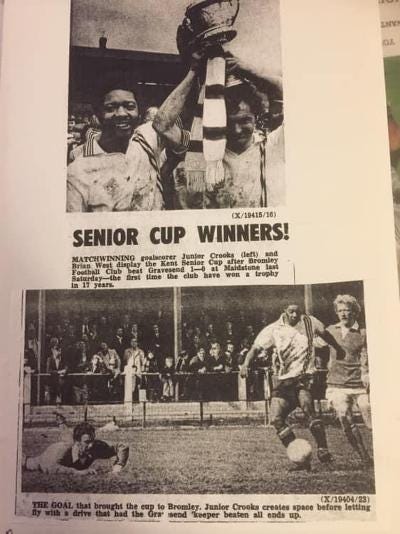



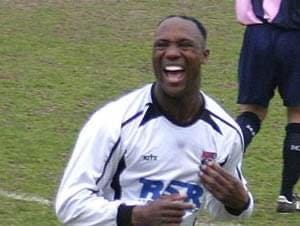

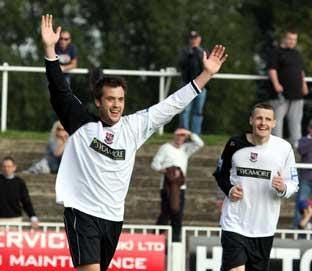
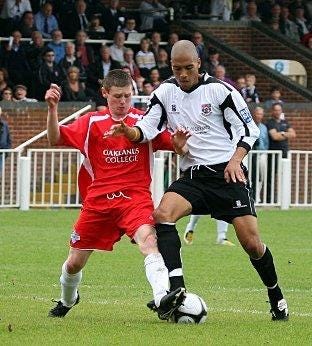


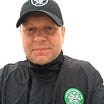
That was fantastic Col. I remember the Cocosports sponsored kit but am struggling to remember where the shop was. Something tells me Chatterton Road but I could well be wrong
Would love to hear more from col. I didn't realise it was a different author until the end and I saw the name, but I was thinking throughout what a great article.